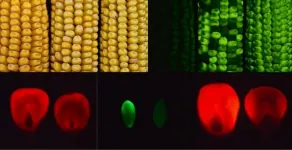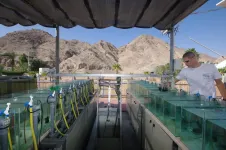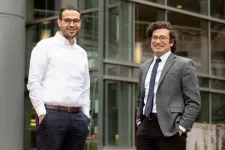(Press-News.org) An abnormal build up of carbohydrates -- sugars and starches -- in the kernels and leaves of a mutant line of corn can be traced to one misregulated gene, and that discovery offers clues about how the plant deals with stress.
That is the conclusion of Penn State researchers whose previous study discovered the Maize ufo1 gene responsible for creating the mutant corn line. They now are assessing its effects and potential for inclusion in breeding new lines of corn better able to thrive in a warming world. The finding of higher sugar levels in plant tissues in their latest study is just another aspect for plant geneticists to consider.
"This discovery has implications for food security and breeding new crop lines that can better deal with a changing climate -- with corn, there is still a lot to be done," said Surinder Chopra, professor of maize genetics in the College of Agricultural Sciences. "In fact, there is a great deal of genetic and phenotypic diversity in corn, and we can use that diversity and ask the question, 'How is the ufo1 gene distributed in the existing 10,000 germplasm lines?'"
Can plant geneticists select for some of that diversity and incorporate the ufo1 gene to improve corn? That is the question Chopra is trying to answer, starting with this new study that found elevated sugar levels in seeds and leaves of the mutant corn line.
What traits can be improved in corn with the ufo1 gene's help?
"Certainly, stress tolerance, but also likely seed development, which has implications in seed yield as well as improved biomass," Chopra said. "And we would like to develop a better plant type that could grow in more dense culture, yet still be more productive. And finally, we need to look at resiliency and sustainability. Can we breed corn lines that get the same amount of yield with lower fertilizer inputs and need less water?"
Chopra started research on the Maize ufo1 gene because of its association with an orange/red pigmentation in the mutant corn line. Celebrated maize geneticist Charles Burnham, at the University of Minnesota, identified this conspicuous ufo1 mutant circa 1960. Another well-known maize geneticist, Derek Styles, with the University of Victoria, Canada, a student of Burnham's, then chose the name, which stands for "unstable factor for orange."
In 1997, Styles sent Chopra seeds for the mutant line. Since then, he introgressed its genes into an inbred line maintained by his research group at Penn State. In 2019, Chopra solved the genetic mystery behind ufo1.
However, it turns out that the gene controls many plant characteristics beyond pigmentation. Still, ufo1 is just one gene, and it is not functioning alone in the corn genome, Chopra noted.
There are more than 30,000 genes in the maize plant, so it is important to learn how ufo1 interacts with other genes before plant geneticists could use it in breeding a new type of crop, he added. "In order to go to the breeding aspect, we first need to learn how this gene actually functions," Chopra said. "We need to learn about how it partners with proteins, and learning about those protein interactions will be the goal of future research."
But for now, this study revealed how accumulation of sugars in corn seed is modified in the presence or absence of the ufo1 gene, according to Debamalya Chatterjee, doctoral student in agronomy, who spearheaded the research.
"Down the road, we could use this knowledge of the ufo1 gene in breeding, to perform better crosses that make more resilient and more productive hybrids, where sugars and starches are in balance," he said.
The researchers took a step in that direction today (May 3) when they published their findings in Plant Physiology, reporting that the maize ufo1 mutant gene affects cell differentiation, influences carbohydrate and hormone accumulation in the plant, and modulates expression patterns of essential genes involved in corn seed development.
All plant materials analyzed in the study were grown during 2016-2020 summers at the Russell E. Larson Agricultural Research Center, Rock Springs, and in greenhouse and plant growth chamber facilities at Penn State's University Park campus. Inbreds and genetic stocks were obtained from the Maize Genetics Cooperation Stock Center managed by the U.S. Department of Agriculture's Agricultural Research Service.
INFORMATION:
Also contributing to this research at Penn State were Kameron Wittmeyer and Jin Cui in the Intercollege Graduate Degree Program in Plant Biology and recent doctoral graduates from the Chopra research group; Neela Yennawar, director, x-ray crystallography and automated biological calorimetry at the Core Facilities, Huck Institutes of the Life Sciences; and Hemant Yennawar, associate research professor of biochemistry. Other members of the research team were Blake Meyers and Tzuu-fen Lee, Donald Danforth Plant Science Center, St. Louis.
The National Science Foundation and an international fellowship from the Indian Council of Agricultural Research supported this work.
May 3, 2021
Using social values for profit cheapens them, a new study cautions.
Toronto - Businesses sometimes align themselves with important values such as a clean environment, feminism, or racial justice, thinking it's a win-win: the value gets boosted along with the company's bottom line.
But be careful, warns new research from the University of Toronto's Rotman School of Management.
Using these values primarily for self-interested purposes such as profit or reputation can ultimately undermine their special status and erode people's commitment to them.
"It sets a different norm for appropriate use of the value," says research author Rachel Ruttan, an assistant professor of organizational behaviour and human resources at the Rotman School, who ...
When it comes to batteries, lithium-ion are the best we have as far as energy density and convenience.
For now.
The Washington University in St. Louis lab of Peng Bai, assistant professor in the Department of Energy, Environmental & Chemical Engineering in the McKelvey School of Engineering, has developed a stable sodium ion battery that is highly efficient, will be less expensive to make and is significantly smaller than a traditional lithium ion battery due to the elimination of a once-necessary feature.
"We've found that the minimal is maximum," ...
Hydraulic fracturing to extract trapped fossil fuels can trigger earthquakes. Most are so small or far from homes and infrastructure that they may go unnoticed; others can rattle windows, sway light fixtures and jolt people from sleep; some have damaged buildings.
Stanford University geophysicists have simulated and mapped the risk of noticeable shaking and possible building damage from earthquakes caused by hydraulic fracturing at all potential fracking sites across the Eagle Ford shale formation in Texas, which has hosted some of the largest fracking-triggered earthquakes in the United States.
Published ...
ATLANTA--An influenza vaccine that is made of nanoparticles and administered through the nose enhances the body's immune response to influenza virus infection and offers broad protection against different viral strains, according to researchers in the Institute for Biomedical Sciences at Georgia State University.
Recurring seasonal flu epidemics and potential pandemics are among the most severe threats to public health. Current seasonal influenza vaccines induce strain-specific immunity and are less effective against mismatched strains. Broadly protective influenza vaccines are urgently needed.
Intranasal vaccines are a promising strategy for combatting ...
BOSTON -- For the first time, researchers have shown how Mullerian inhibiting substance (MIS), also known as anti-Mullerian hormone, a key reproductive hormone, suppresses follicle development and prevents ovulation in females. "Understanding the mechanism of follicle development by MIS opens the door to creating novel approaches to contraception, preserving the eggs of young girls undergoing chemotherapy, enhancing the success of fertility treatment, and potentially delaying menopause," says David Pépin, PhD, an associate molecular biologist in the Department of Surgery at Massachusetts General Hospital (MGH) and senior author ...
Even under the most optimistic scenarios, most of the coral reef ecosystems on our planet - whether in Australia, the Maldives or the Caribbean - will have disappeared or be in very bad shape by the end of this century. That's because global warming is pushing ocean temperatures above the limit that single-cell algae, which are corals' main allies, can withstand. These algae live inside coral tissue for protection and, in exchange, provide corals with essential nutrients produced through photosynthesis. Because the algae contain a variety of pigments and therefore give coral reefs their famous colors, if they are lost the corals turn white, which is known as coral bleaching. But in spite of the real threat caused by global warming, corals in the ...
Abu Dhabi, UAE, May 3, 2021: Researchers from NYU Abu Dhabi's Center for Genomics and Systems Biology have successfully sequenced the genome of previously extinct date palm varieties that lived more than 2,000 years ago. They did so using date palm seeds that were recovered from archaeological sites in the southern Levant region and radiocarbon-dated from the 4th century BCE to the 2nd century CE. The seeds were germinated to yield viable, new plants. The researchers conducted whole genome sequencing of these germinated ancient samples and used this genome data to examine the genetics of these previously extinct Judean date palms. This study marks the first time researchers have sequenced the genomes of plants ...
First-of-its-kind model replicates human alveolar lung tissue
Allows researchers to study effects of COVID-19 on cell growth and development
Provides insight as to how various drugs impact viral spread
Globally, lung failure is one of the leading causes of death. Many conditions can affect and damage the lungs, including asthma, chronic obstructive pulmonary disease, influenza, pneumonia, and, most recently, COVID-19. To better understand respiratory diseases and develop new drugs faster, investigators from Brigham and Women's Hospital designed a ...
CHAMPAIGN, Ill. --A new study found overlooked tsunami hazards related to undersea, near-shore strike-slip faults, especially for coastal cities adjacent to faults that traverse inland bays. Several areas around the world may fall into this category, including the San Francisco Bay area, Izmit Bay in Turkey and the Gulf of Al-Aqaba in Egypt.
The study led by University of Illinois Urbana-Champaign civil and environmental engineering professor Ahmed Elbanna and professor Ares Rosakis of the California Institute of Technology used the Blue Waters supercomputer at the National Center for Supercomputing Applications to model ...
ALBUQUERQUE, N.M. -- Sometime between 50,000 and 70,000 years ago, prehistoric humans took their first steps into Sahul, an ancient landmass made up of modern Australia, New Guinea and Tasmania. But nobody knows which way they went after that.
"One of the really big unanswered questions of prehistory is how Australia was populated in the distant past. Scholars have debated it for at least 150 years," said Sandia National Laboratories archaeologist and remote sensing scientist Devin White.
Now, an international team of scientists using a Sandia supercomputer in the largest reconstruction ...





